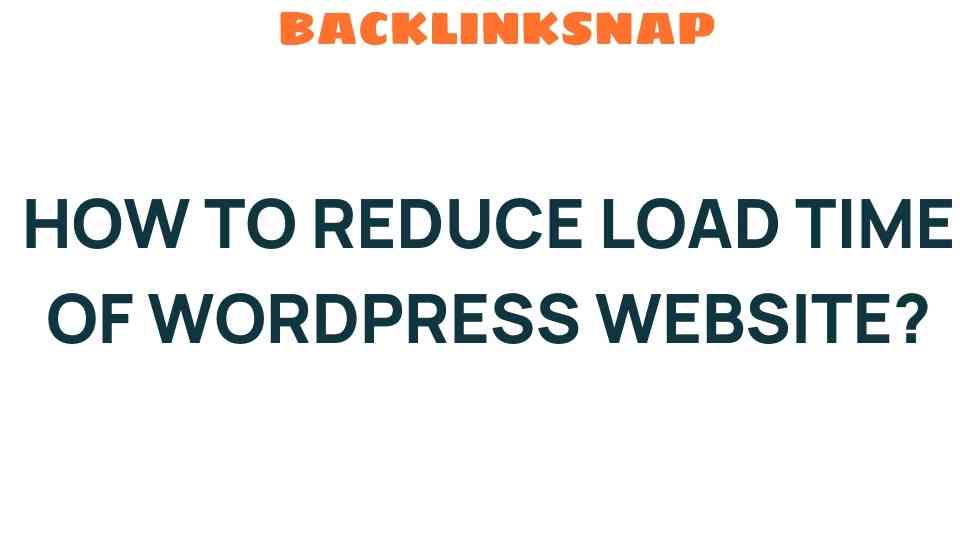Unlocking Speed: How to Reduce Load Time of Your WordPress Website
In today’s fast-paced digital world, website speed is paramount. A slow-loading website can frustrate users and lead to high bounce rates, ultimately impacting your site’s performance and conversion rates. If you’ve ever wondered how to reduce load time on your WordPress website, you’re in the right place. In this article, we’ll explore effective WordPress optimization techniques, discuss caching solutions, delve into image compression, and evaluate hosting choices and plugin management strategies that can significantly improve performance.
Understanding the Importance of Website Speed
Website speed is not just about numbers; it’s about user experience. Research shows that a delay of just a few seconds can lead to a significant drop in visitor engagement. According to Google, 53% of mobile users abandon sites that take longer than three seconds to load. Moreover, faster sites tend to rank better in search engines, giving you an edge over competitors.
To effectively reduce load time, it’s essential to adopt a comprehensive approach that encompasses various aspects of your website. Let’s break this down into actionable steps.
Caching Solutions: A Game Changer
Caching is one of the most effective ways to enhance your website speed. It stores a static version of your website, which is delivered to users instead of generating the page dynamically with each visit. This can dramatically cut down on load times.
- Choose a Reliable Caching Plugin: Plugins like WP Rocket or W3 Total Cache are excellent choices. They optimize your site with minimal setup.
- Enable Browser Caching: By doing this, return visitors will load your page faster as their browser will store certain elements.
- Page Caching: This means saving the full output of a page to serve to users without having to execute PHP scripts each time.
Image Compression: Lighten the Load
Images often take up a significant portion of a webpage’s size, which can slow down loading times. Optimizing images is crucial for WordPress optimization.
- Use Compression Tools: Tools like TinyPNG or plugins like Smush can compress images without sacrificing quality.
- Choose the Right Format: Use JPEG for photographs and PNG for images with transparency. Consider using newer formats like WebP, which offer better compression.
- Implement Lazy Loading: This technique loads images only when they enter the viewport, reducing initial load time.
Choosing the Right Hosting Solutions
The foundation of your website’s speed lies in your hosting choice. Not all hosting providers offer the same performance.
- Consider Managed WordPress Hosting: Services like Kinsta or WP Engine provide optimized environments specifically for WordPress.
- Look for SSD Storage: Solid State Drives (SSD) are significantly faster than traditional hard drives, which can dramatically improve load times.
- Evaluate Server Location: Choose a host with data centers closer to your target audience to reduce latency.
Plugins Management: Quality Over Quantity
While plugins can enhance functionality, having too many can bog down your site. Managing your plugins effectively is crucial for improving performance.
- Audit Your Plugins: Regularly review your plugins and disable or delete those that are unnecessary or outdated.
- Opt for Lightweight Plugins: Some plugins are resource-heavy. Look for alternatives that provide the same functionality with less impact on speed.
- Update Regularly: Keeping your plugins updated ensures they run efficiently and securely, which can also help with performance.
Minification and Concatenation of Files
Minification refers to removing unnecessary characters from your code (like whitespace) without changing functionality, while concatenation involves combining multiple files into one. Both practices can help reduce load time.
- Use Minification Plugins: Plugins like Autoptimize can help automate this process.
- Combine CSS and JavaScript Files: This reduces the number of requests made to the server, speeding up loading times.
Utilizing Content Delivery Networks (CDNs)
A CDN distributes your site’s content across several global servers, allowing users to download data from the server closest to them. This can significantly improve loading times.
- Choose a Reliable CDN: Services like Cloudflare or MaxCDN are popular options that can help enhance speed.
Regular Monitoring and Testing
Finally, consistently monitoring your website’s performance is paramount. Tools like Google PageSpeed Insights or GTmetrix provide valuable insights into your website’s speed and can help identify areas for improvement.
By implementing these strategies, you can effectively reduce load time, optimize your WordPress site, and improve overall performance. Remember, a fast website not only enhances user experience but also boosts your search engine rankings.
FAQs
- What is considered a good website load time?
A good load time is generally under three seconds. However, the faster, the better. - How do caching plugins work?
Caching plugins store a static version of your site, allowing it to load faster by reducing server load. - Can I compress images without losing quality?
Yes, using tools like TinyPNG or plugins like Smush, you can compress images significantly while preserving quality. - What is the role of a CDN?
A CDN speeds up your website by distributing content across multiple servers worldwide, reducing load times for users. - Do I need to update my plugins regularly?
Absolutely! Regular updates not only improve performance but also enhance security. - How can I test my website speed?
You can use tools like Google PageSpeed Insights or GTmetrix to analyze and test your website speed.
Conclusion
Reducing load time on your WordPress website is not only achievable but essential. By incorporating effective caching solutions, optimizing images, choosing the right hosting, managing plugins wisely, and utilizing CDNs, you can dramatically improve your website’s speed and performance. Regular monitoring will help ensure that your site remains fast and user-friendly. Embrace these strategies, and you’ll unlock the potential of your website, leading to a better user experience and improved search engine rankings.
This article is in the category Website Performance and created by BacklinkSnap Team




